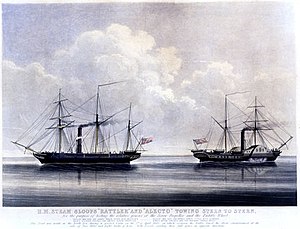HMS Rattler (1843)

Rattler (left) and Alecto (right) in their 1845 competition
|
|
| History | |
|---|---|
|
|
|
| Name: | HMS Rattler |
| Ordered: | 24 February 1842 |
| Builder: | Sheerness Dockyard |
| Cost: | £9,400 plus £17,413 for fitting |
| Laid down: | April 1842 |
| Launched: | 13 April 1843 |
| Commissioned: | 30 January 1845,Woolwich |
| Fate: | Broken up, 1856 |
| General characteristics | |
| Class and type: | Screw sloop |
| Displacement: | 894 tonnes |
| Tons burthen: | 866 80/94 bm |
| Length: | 185 ft (56.4 m) |
| Beam: | 32 ft 8.5 in (10.0 m) |
| Draught: | 11 ft 5 1⁄2 in (3.5 m) (mean) |
| Depth of hold: | 18 ft 7.5 in (5.7 m) |
| Installed power: |
|
| Propulsion: |
|
| Sail plan: | Barquentine |
| Speed: | 9.6 knots (17.8 km/h) |
| Complement: | 180 |
| Armament: |
|
HMS Rattler was a 9-gun wooden sloop of the Royal Navy and the first British warship to adopt a screw propeller powered by a steam engine. She was arguably the first such warship in the world—the sloop USS Princeton was launched after the Rattler, but was placed in commission much sooner.
Screw propulsion had some obvious potential advantages for warships over paddle propulsion. Firstly, paddlewheels were exposed to enemy fire in combat, whereas a propeller and its machinery were tucked away safely well below deck. Secondly, the space taken up by paddlewheels restricted the number of guns a warship could carry, thus reducing its broadside. These potential advantages were well understood by the British Admiralty, but it was not convinced that the propeller was an effective propulsion system. It was only in 1840, when the world's first propeller-driven steamship, SS Archimedes, successfully completed a series of trials against fast paddle-wheelers, that the Navy decided to conduct further tests of the technology. For this purpose, the Navy built Rattler.
Rattler was launched on 13 April 1843 at Sheerness Dockyard and towed to Maudsley's yard to have her machinery installed. She received a four-cylinder vertical single-expansion steam engine with double cylinders, rated at 200 nhp and developing 437 indicated horsepower (326 kW). She was coppered at Woolwich Dockyard and spent two years on trials, with her first day at sea on 30 October 1843. Her armament consisted of a single 8-inch (60 cwt) pivot gun and eight 32-pounder (25cwt) broadside guns. She was commissioned at Woolwich on 30 January 1845 and was first commanded by Commander Henry Smith.
Rattler was pitted against a number of paddlewheelers from 1843 to 1845. These extended trials were to prove conclusively that the screw propeller was as good as, indeed superior to, the paddlewheel as a propulsion system. The most famous of these trials took place in March 1845, with Rattler conclusively beating HMS Alecto in a series of races, followed by a tug-of-war contest in which Rattler towed Alecto backwards at a speed of 2 knots (3.7 km/h). It is this which is memorialised to this day in Portsmouth Historic Dockyard. A large number of propellers were also tested on Rattler during this period to find the most effective screw design.
...
Wikipedia
